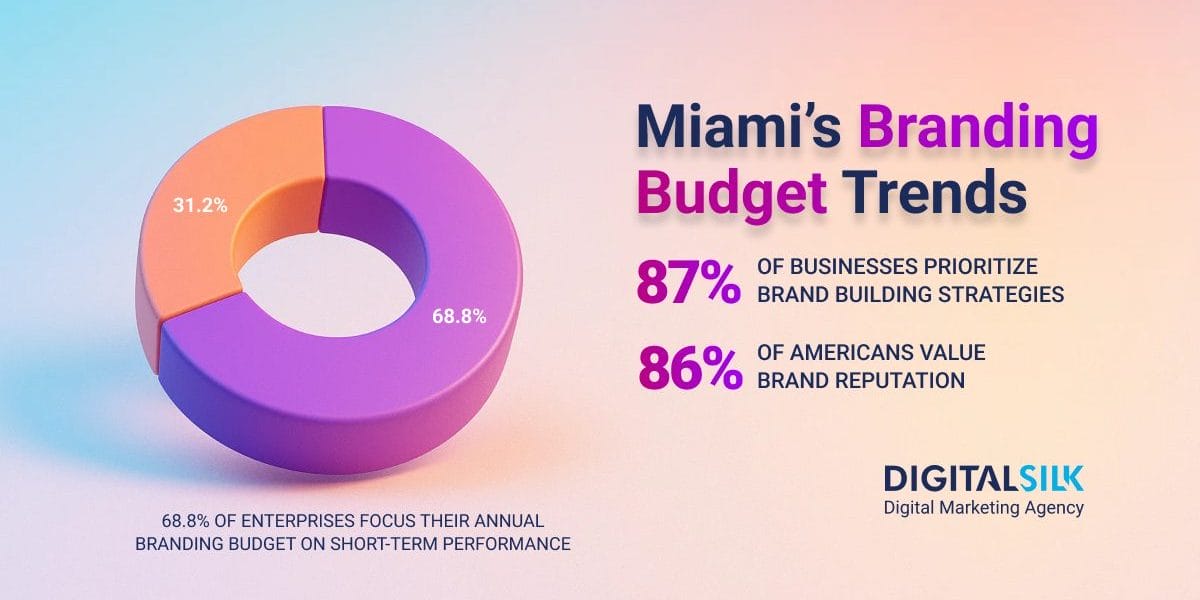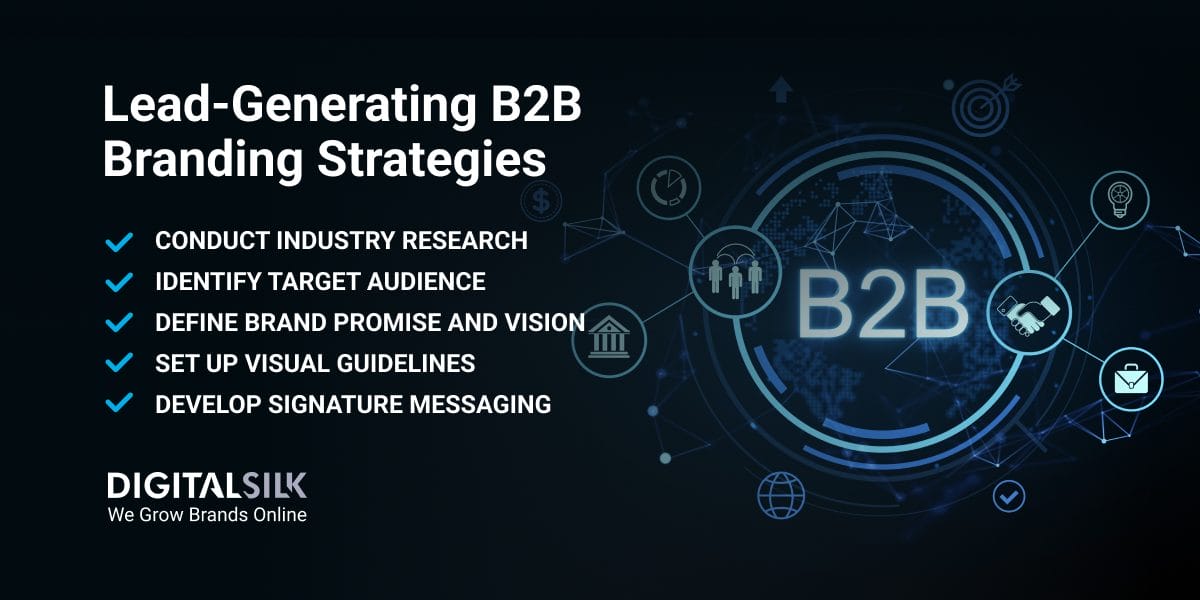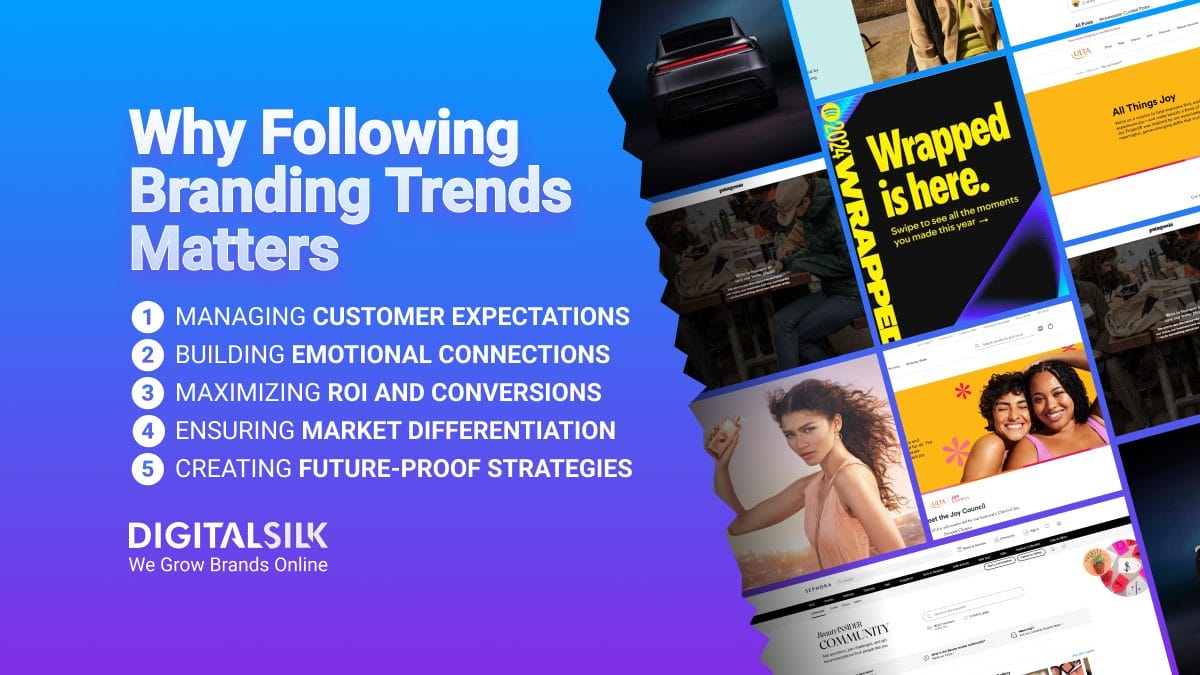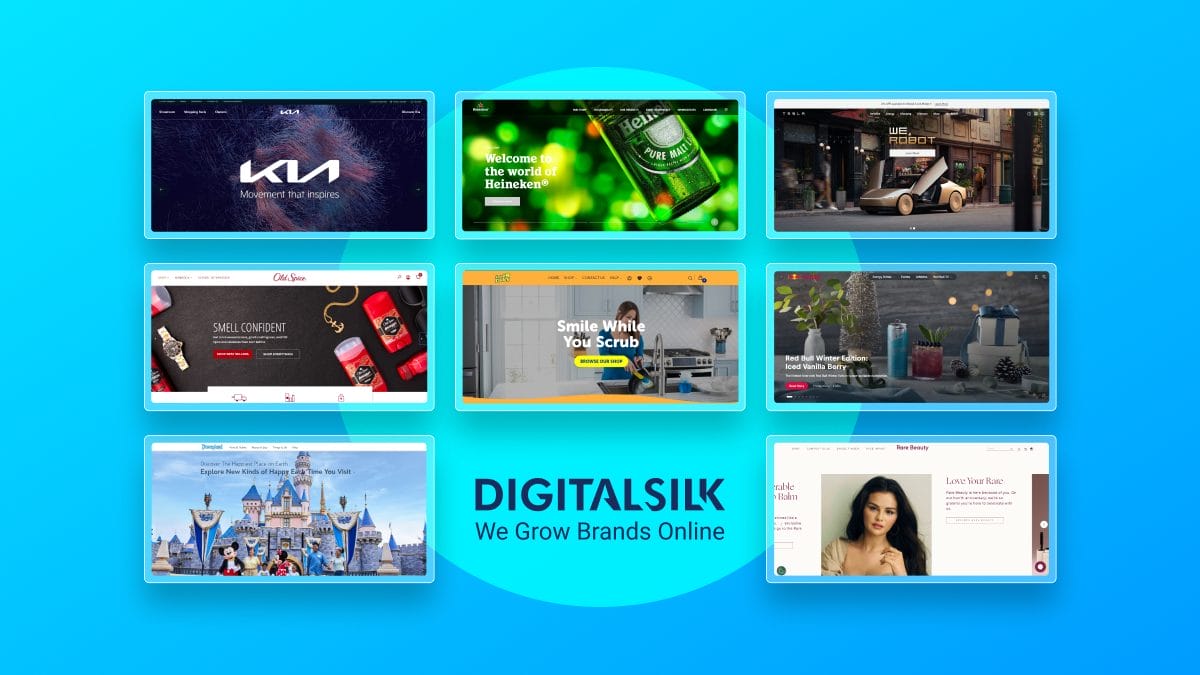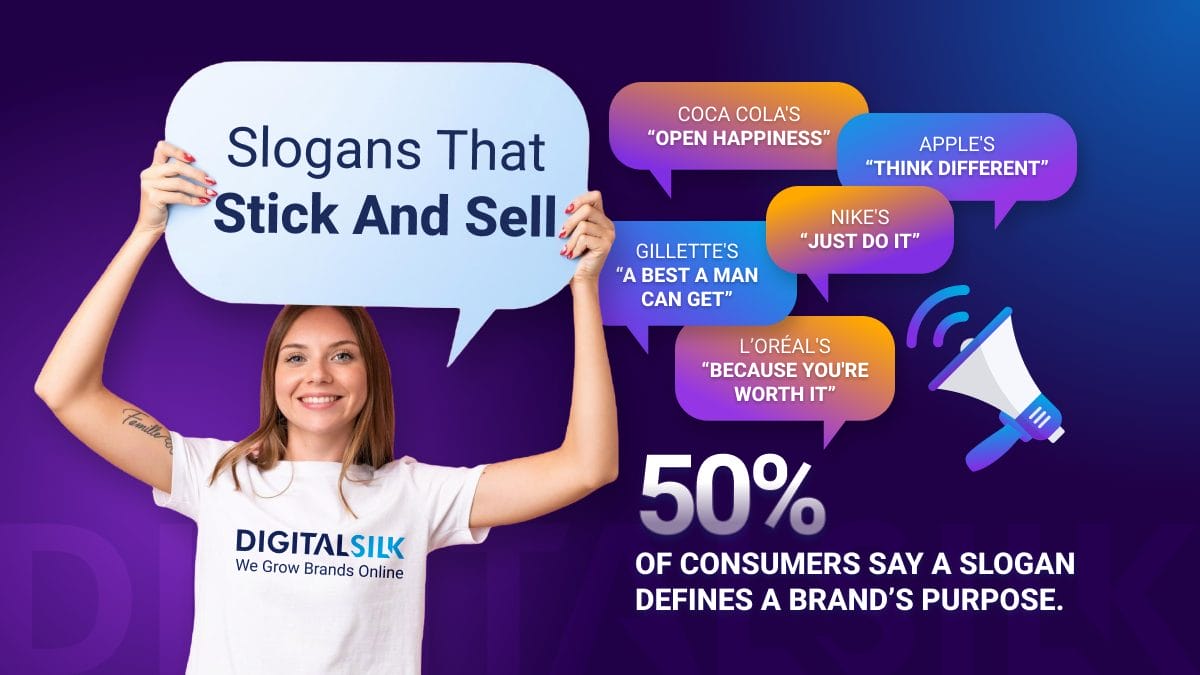Miami Branding Budget Statistics: Key Highlights
-
Carnival Corp, Royal Caribbean and Norwegian Cruise Line collectively spent over $3.5 billion on brand-related expenses in 2024.
-
In 2024, only 38% of marketing budgets went to top-of-funnel brand awareness, while 53% focused on demand generation.
-
87% of consumers say brand trust directly influences their willingness to pay more, making reputation a key revenue driver.
Miami branding budget statistics show that the city’s business leaders aren’t shy when it comes to investing in their brands, but the gap between perception and best practice is still costing market share.
In 2024, CMOs nationwide allocated 68.8% of their budgets toward long-term brand building, a slight increase from 2023 and well above the “ideal” 50-50 split between long-term strategies and short-term performance marketing.
For the city’s big players, where competition is fierce and consumer loyalty is fragile, knowing how much is too much or not enough can make the difference between staying top of mind or fading into the noise.
In this post, we’ll unpack the latest Miami branding budget statistics and what they reveal about where the city’s biggest businesses are focusing their spend.
How The Top Players Manage Branding Costs In Miami
Branding budgets influence how Miami’s largest companies stay visible and build long-term customer relationships.
Cruise lines, homebuilders and other major players are making substantial investments to strengthen awareness and drive engagement.
The Miami branding budget statistics below show the scale of spending behind some of the city’s most recognizable brands.
- The U.S. branding agency services market is expected to generate $4.63 billion in sales revenue in 2025 and reach $10.24 billion by 2033, growing at a CAGR of 10.415%.
- Carnival Corporation, headquartered in Miami, spent $925 million on selling expenses in 2024, including marketing and brand promotion.
- The Royal Caribbean Group recorded $2.125 billion in marketing, selling and administrative brand expenses for 2024.
- Norwegian Cruise Line Holdings invested $513 million in advertising and brand-related costs over the past 12 months.
- Lennar Corporation, one of Miami’s major homebuilders, invested $190.9 million in brand advertising in 2024.
What This Means For Enterprise Branding In Miami
- Big brands aren’t treating marketing as a discretionary spend. Consistent, large-scale investment is a strategic choice to protect market position and drive long-term growth.
- Brand visibility is becoming a spend-driven game. The cruise lines and homebuilders dominating the market are signaling that long-term awareness demands sustained financial commitment.
- Outsourcing is driving results at scale. The growth in agency market size suggests that in-house teams alone may struggle to execute at the needed volume and speed.
General Miami Marketing Budget Trends
Despite widespread agreement on the importance of brand building, branding costs in Miami continue to lean heavily toward short-term performance goals.
Marketers are funneling more budget into demand generation while underspending on top-of-funnel awareness, even as only a small portion of media channels deliver both sales and brand return on investment (ROI).
The data below shows how this imbalance is shaping growth outcomes, with brands perceived as more meaningful and different capturing stronger brand value gains.
- 87% of CMOs believe that brand-building is a top priority for their organization.
- 70% of professionals say they would prioritize performance marketing over brand building.
- Only 36% of media channels deliver above-average performance when it comes to driving both sales and brand awareness, with digital display adds topping that list.
- In 2024, just 38% of marketing spend went to top-of-funnel brand awareness, while 53% focused on demand generation, leaving many brands vulnerable to a drop in long-term visibility.
- Brands rated as “highly meaningful and different” saw a 19% greater brand-value growth in 2024.
What This Means For Enterprise Branding In Miami
- Stating that brand building is a priority isn’t enough. Without real budget alignment, long-term brand strength in Miami will continue to erode.
- Over-focusing on demand generation leaves a visibility gap. Underspending on top-of-funnel awareness is making it harder for brands to build lasting customer relationships.
- Media channel selection matters more than ever. With so few channels driving both sales and awareness, investing in the right mix is critical for efficiency.
Consumer Perception Of Big Business Branding In Miami
Consumer expectations around authenticity, trust and emotional connection are reshaping how major brands approach corporate branding in Miami in 2025.
From product quality and sustainability to optimism and nostalgia, people are responding to brands that deliver meaningful experiences and align with their personal values.
The data below highlights how these perception shifts influence loyalty, price tolerance and brand preference across key industries.
- 98% of consumers report that brand authenticity matters to them on some level when deciding which products or services to buy.
- For 56% of those users, brand authenticity means delivering consistent quality in both products and services.
- 87% of consumers say brand trust directly influences their willingness to pay more.
- 69% of users rank brand reputation as a primary reason for brand trust, tied with product quality and value for first place.
- 86% of Americans say it’s important to them that brands maintain a good reputation.
- 80% of consumers report they’re open to spending extra on goods that come from sustainable production or sourcing practices.
- 76% of people now expect brands to build optimism directly into their messaging and positioning, a shift that’s grown steadily over the past five years.
- 60% of U.S. consumers believe that brands should make them feel good during turbulent times.
- 77% of B2B buyers say brand awareness influences whether they trust an organization enough to make a purchase.
- 73% of Americans would continue buying from their favorite brand even if prices skyrocketed tomorrow.
- 71% of them are more inclined to choose brands that tap into childhood nostalgia, giving marketers a clear emotional lever for building preference.
- 58% of those users remain loyal to brands that provide positive experiences.
- 64% of consumers prefer interacting with brands that offer personalized experiences, whereas 53% of them are concerned about the privacy of their personal information.
What This Means For Enterprise Branding In Miami
- Authenticity is no longer optional. Consumers expect brands to deliver consistent quality and communicate with honesty across every touchpoint.
- Reputation is a currency. How your brand is perceived today directly shapes both trust and consumers’ willingness to pay more tomorrow.
- Emotional connection drives loyalty. Brands that build optimism, nostalgia and positive experiences into their messaging are earning stronger long-term followings.
How Miami’s Culture Influences Brand Strategies & Spending
Miami business advertising data shows that brand strategies in this city are shaped as much by cultural nuance as by budget allocations.
To stay relevant, companies are tailoring their messaging and creative investments to reflect the energy, diversity and lifestyle expectations unique to the city’s market.
- Culturally relevant messaging: Brands are creating campaigns that reflect the city’s blend of Latin American, Caribbean and international influences by incorporating multilingual content and culturally specific narratives that resonate with different audience segments.
- Experience-led engagement: Immersive events, pop-up activations and sponsorships tied to major cultural moments like Art Basel and the South Beach Wine & Food Festival can help brands build deeper consumer connections.
- High-Impact visual storytelling: Vivid colors, bold graphics and design choices inspired by Miami’s street art, architecture and nightlife scenes are becoming a creative standard for brands seeking to capture attention.
- Sustainability-centered positioning: With local concerns about climate and environmental preservation growing, brands that showcase authentic commitments to sustainability are seeing stronger trust and engagement from South Florida consumers.
- Emotionally driven narratives: Campaigns that tap into local pride, community resilience or shared nostalgia can perform well, as the city’s audiences continue to respond to messaging with emotional relevance.
- Lifestyle-aligned campaigns: Brands are embedding themselves into Miami’s cultural fabric by aligning with popular categories like fitness, culinary trends, music and fashion, creating campaigns that feel native to the city’s way of life.
Common Challenges In Managing Branding Budgets
The ongoing growth in Miami enterprise marketing spend doesn’t always automatically translate into stronger and more recognizable brands.
Many organizations are increasing budgets but still struggling with how much to allocate toward long-term brand building versus short-term performance.
The following challenges continue to limit brand impact across industries:
- Misalignment between goals and budget allocation: Many organizations state that brand building is a priority, but their enterprise marketing spend often leans heavily toward short-term performance campaigns at the expense of top-of-funnel awareness.
- Fragmented media strategies: With few channels delivering both sales and brand lift, marketers struggle to build a media mix that supports both immediate conversions and long-term visibility.
- Pressure for immediate ROI: The demand for fast, measurable results pushes teams toward lower-funnel tactics, often sidelining the investments needed for sustained brand growth.
- Lack of internal consensus: Marketing, sales and leadership teams frequently disagree on key performance indicators (KPIs) and budget priorities, creating friction and slowing decision-making around branding investments.
- Difficulty measuring brand impact: Without clear frameworks that connect brand spend to revenue or business outcomes, many leaders remain hesitant to increase budget allocations for long-term brand building.
- Resource strain on internal teams: Managing complex, multi-channel brand campaigns often stretches internal teams beyond capacity, leading to execution gaps or over-dependence on external partners without clear strategic direction.
Grow Your Miami Brand With Digital Silk
Competing for attention in Miami’s fast-moving market demands more than just increasing spend.
It requires making smarter decisions about where and how to invest in brand-building efforts that drive both visibility and long-term business growth.
At Digital Silk, our experienced and knowledgeable branding team works closely with Miami enterprises to develop tailored strategies, identify high-impact channels and execute campaigns that turn branding costs into measurable brand value.
As a professional web design and branding agency, our services include:
Contact our team, call us at (800) 206-9413 or fill in the Request a Quote form below to schedule a consultation.
"*" indicates required fields


